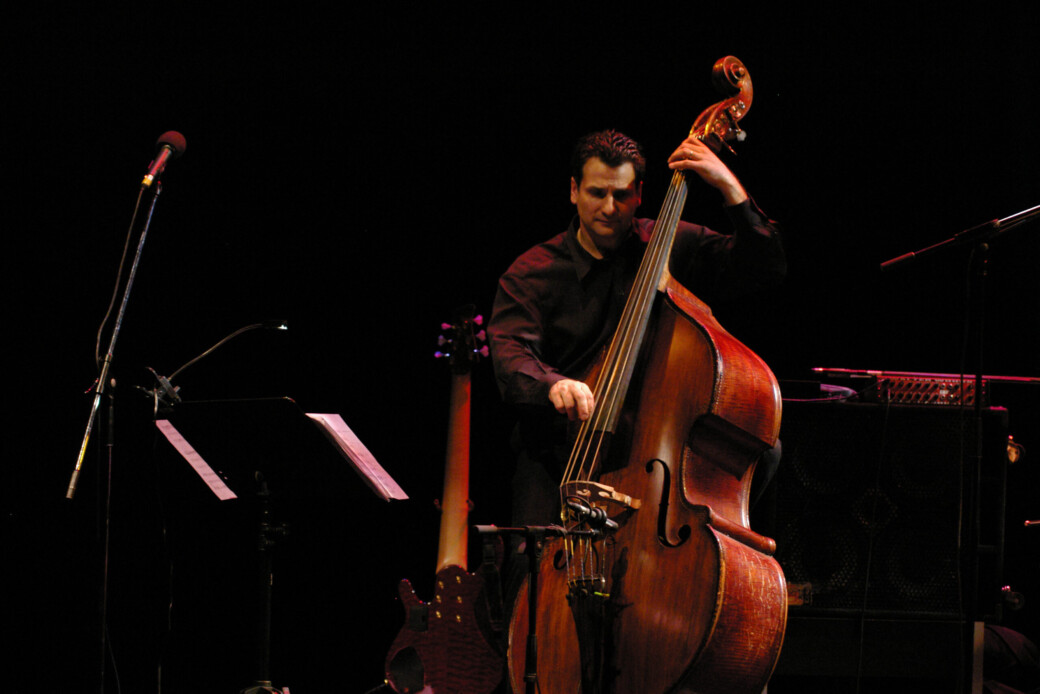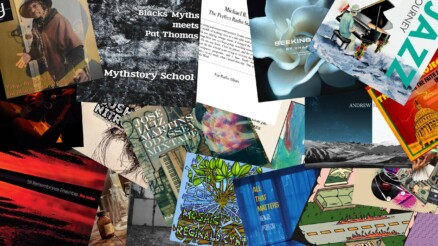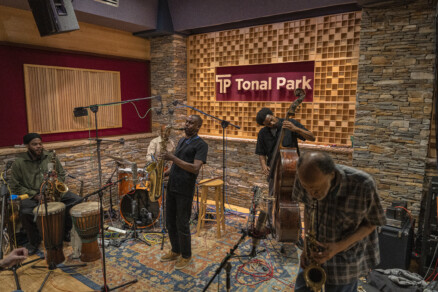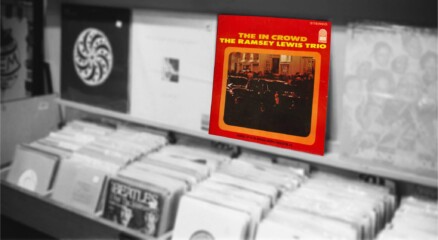John Patitucci on upholding the legacy of Wayne Shorter

During the 20-year lifespan of the Wayne Shorter Quartet, the group stood as one of the most ecstatic in music, let alone “jazz.” Anchoring the unit during those years was the bass work of John Patitucci, who held together the controlled chaos of Brian Blade’s blur behind the kit, Danilo Pérez’s speedy harmonic scaffolding on piano, and Shorter blowing to high heaven.
While Patitucci is not as naturally showy as Blade or Pérez, watch him – during, for instance, this performance at Bonn in 2014 – and you can see him rocking and reeling, sticking his tongue out in a combination of joy, surprise and a little bit of “boy I hope I can keep a hand on this thing” rising to the challenge. Through it all, Patitucci never loses control, maintaining a tether back to earth in “zero gravity” while propelling the music forward just as forcefully as his bandmates.
That cornerstone quality is one that Patitucci has loaned to all the bands he’s performed with, from his own Electric Guitar Quartet (which finds Patitucci trading his usual acoustic upright for a six-string electric bass) to Chick Corea’s Akoustic and Elektric Bands in the 1990s. This comes from being a first-rate musician and listener, of course, but is also a quality that Patitucci says he picked up early on from one of his first bass heroes: James Jamerson. A session bassist largely uncredited for most of his life, Jamerson shaped the low end for Motown’s era-defining hits in the 1960s and 1970s, playing in a way that influenced everyone from Rush’s Geddy Lee to Marcus Miller. Praising his work on songs like “My Girl,” “Ain’t No Mountain High Enough,” and “Shotgun” during his induction into the Fender Hall of Fame, Smokey Robinson said of Jamerson, “he had another way of carrying the rhythm section. He was so dominant while being subtle.”
Subtlety is the lifeline of a bassist; Patitucci knows how to make it a creative strength, too. This was heard plainly on his latest solo album, the 13-song Soul of the Bass, which he released just before the start of the coronavirus pandemic.
Patitucci will return to D.C. this Wednesday in what will be a bittersweet event, as he joins Pérez and Blade in offering tribute to their mentor and guide Shorter, who ascended in March 2023. The group will perform at the Kennedy Center on Wednesday, Oct. 23, and will be joined by saxophonist Mark Turner for an adventure into the unknown.
I spoke to Patitucci via Zoom on Friday – fulfilling a yearslong goal to interview every member of the Shorter quartet for this publication – to talk about Shorter’s legacy and impact on him personally, and the unique challenges Shorter’s music presented to him as an electric and acoustic bass player.
This interview has been edited for length and clarity.
CapitalBop: Having interviewed both your bandmates Danilo and Brian, it sounded like playing with Wayne for all that time – and you even started earlier, in the ‘80s – changed their musical DNA, or at least had lasting impact on them. What impact did Wayne Shorter have on you as a musician?
John Patitucci: He was like a second father in certain ways. … I remember I met him through Chick in ’86, we did a tour called “Chick, Wayne and Al.” I was playing in Chick’s Electrik Group and Wayne had started to finally really do his own band touring wise … Having met him in ’86 and recorded with him on Phantom Navigator in 1987, that was a huge thing, [playing with] one of the big heroes in my musical life. [He was] one of the first people I heard when I first heard jazz when I was a kid in Brooklyn. My grandfather brought home these records for my brother and I, and Art Blakey and the Jazz Messengers’ Mosaic was one of them, which had the tune “Children of the Night” – which is why I came up with the idea of “Children of the Light” for the trio. I heard that music and, even though I didn’t understand any of it, it touched me emotionally. He began changing my life then. … It was then a big deal meeting him and getting to know him.
We hit it off in many ways and he started calling me even though I was still with Chick in the late ’80s and the early ’90s. We had a pretty cool band – we didn’t play a lot but we played a bit – with Terri Lyne Carrington and Mitch Forman and sometimes [Mino] Cinelu on percussion. Playing with that band was really intense. That was a big watershed for me because the music was from [Shorter’s 1985 album] Atlantis and the bass lines were all very involved. Wayne wrote incredible bass lines. Just learning the music and experiencing the music was so beautiful, so brilliant. Then, the thing that really wiped me out is that all that music is through composed on Atlantis and the solos are all in one chord. What he did with one chord – he could make you cry with one note or play eight-million notes, but it was very emotionally driven and the depth of spirit and everything he played with was so powerful that it changed my whole thing. It taught me I needed to have more courage to just hang a note in the air and not hide behind density or technique.
CB: When you say he wrote very involved bass lines, could you elaborate on that? What distinguished a Wayne bass line?
JP: Well, they were technically challenging but they were also musically very deep and much more developed than what people write for the bass. If you listen to a lot of his records there’s contrapuntal bass lines that run through the thing: “Forbidden, Plan-It!” and some of the stuff on High Life later on. The orchestral music that he writes is very technically advanced and very contrapuntally deep bass line where the bass is a melodic voice underneath it all. If you listen to the record Alegría there’s all kind of bass lines on that record. Listen to his version of “Serenata” and “Angola” there’s all this stuff if you listen carefully. But it’s so seamless it might go under the radar.
CB: I think you said something like the bass lines were such that you couldn’t hide behind subtlety–
JP: No no, you couldn’t hide behind – not subtlety, [because] you needed subtlety if you wanted to play like Wayne. You couldn’t hide behind density. You couldn’t just, sort of, swashbuckle your way through and blow your way out of it. All of a sudden you had one chord and you had to build a solo and make a statement and tell a story. Wayne was incredible at that. He was, to me, the only person after Miles [Davis] who did that on an instrument so deeply, you know what I mean? In Wayne’s case, he was quite a virtuoso on the saxophone, he could really get around. But he could also play one note or when he played soprano sometimes it was so human and vocal that it would easily make you cry. And he did make me cry. I’d be on the bandstand and he’d look at me after a solo and go, “Want some?” And I’d be like, “No!” [laughs] and then he’d joke around with me and say, “Go, Paganini! Go!” He liked to hear the bass really stretch out. In the quartet too, he would love it when I used the bow. He would say, “You be the violin and while I’ll be the bass.”
CB: I wanted to hit on that point of subtlety. I was watching a video of a masterclass you did in 2019 in which you talked about how, at the same time you’re hearing Jymie Merritt on Mosaic, you were also soaking up James Jamerson. Smokey Robinson has described Jamerson’s playing as “dominant” while being “subtle.” Could you talk about the impact that Jamerson had on you?
JP: Jamerson was huge for me! At the same time we were hearing some of those jazz records … the soundtrack in the ’60s when I was growing up in East Flatbush was a ton of Motown records, as well as The Beatles and other things. Jamerson was creating music history on all those records [by] Stevie Wonder, Diana Ross, the Temptations and so many artists that were on the radio. Hearing Jamerson’s bass lines, the first two that really made me want to play the bass, were the first time I heard “I Was Made To Love Her” and “For Once In My Life,” those two Stevie Wonder hit records. The bass was mixed up front, [so that] even in my father’s ’50s chevy, you could hear the bass. [Jamerson’s] bass lines were powerful, they were beautiful, and they were actually active in a contrapuntal way. The drummers played simply on those records, so he was threading all this music together with his bass lines. He was just as responsible for how those records were hits as anyone else.
CB: Is that how you saw yourself in the Wayne Shorter quartet? What did you feel that your role in the band was, especially in those big ecstatic moments with the other members?
JP: At the center of what Brian and I were always about was still groove, even though people might say, “Well, that was such an abstract group.” If you listen carefully, there were a lot of grooves that we would cook up underneath the stuff Danilo and Wayne were doing. We’d sneak in little grooves and different things. There’s a heartbeat in a lot of the stuff, but it’s not as obvious. Because Brian is also very versed in the history of jazz music, as I am, but also in the history of R&B, soul music, gospel music. And we were drawing on all the rhythmic structures that came from Africa that defined not only American music but music from Cuba, Puerto Rico, Panama, Argentina, Venezuela – and of course Danilo is a music historian who’s hip to a lot of stuff too. And Wayne grew up listening to all those incredible bands that were playing in Harlem – all the bands that were at the forefront of not only the Nuyorican Puerto Rican style but also Cuban bands and all that.
That’s all in the mix, it’s all kind of mixing around. Not only were we all invested in bebop too – in fact, I don’t know if you know about this story. One time we played in Detroit and Wayne was so unpredictable as an improviser, he decided – since we were in Detroit – all of a sudden he started playing Bird tunes. We were like, “Wow, we’re really gonna do this!” Sometimes he didn’t really want to access that so much, he was always wanting to press on that he hadn’t played. And the audience flipped out and we just started swinging! For us, it wasn’t surprising but it was. We weren’t used to him initiating that in the quartet context.
CB: Between the memorial last year that Herbie organized at the Hollywood Bowl and these shows with Mark Turner, what’s it been like revisiting this music without Wayne?
JP: Whenever the trio plays we feel his spirit there. He’s very much a part of our lives, as he always was. We’ve also done things with Terri Lyne and esperanza [spalding] and the orchestra stuff, and all these different kinds of experiences are ways to bring him to the forefront of people’s minds again. He’s someone we’re never gonna forget. His music is so strong – it lives and breathes. Danilo and Brian and I did something with Chris Potter and Ravi Coltrane and now we’re spreading it around, calling on these tenor saxophone voices that have such an identity. Mark Turner is another one who has such a sound of his own. Wayne was very personal in his sound, so it’s cool we’re calling on people who are not only Wayne lovers and have thoroughly immersed themselves in his music, but each has an individual sound.
CB: So, it’s another way to press on what you haven’t played, in some senses.
JP: Yeah, yeah. They’re jumping in there and they’re being pulled into the way the trio plays that music and they’re responding. They’re all sensitive musicians who are brilliant, and they jump in in their own way. It will be fun to see now Mark’s take on the music, and how he reacts to it.
Brian Blade, Danilo Perez, DC, DC jazz, jazz, John Patitucci, Washington, Wayne Shorter




